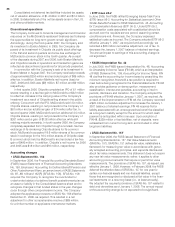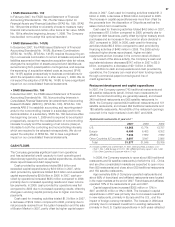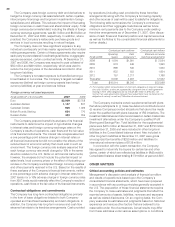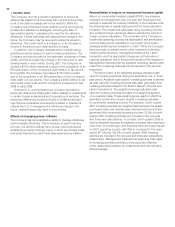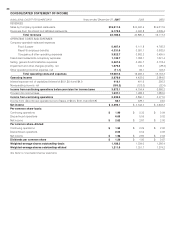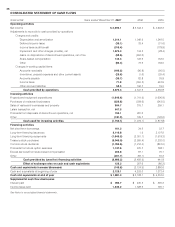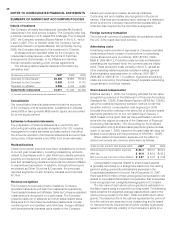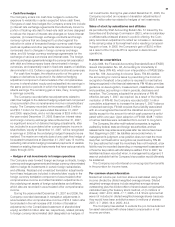McDonalds 2007 Annual Report Download - page 44
Download and view the complete annual report
Please find page 44 of the 2007 McDonalds annual report below. You can navigate through the pages in the report by either clicking on the pages listed below, or by using the keyword search tool below to find specific information within the annual report.• Income taxes
The Company records a valuation allowance to reduce its
deferred tax assets if it is more likely than not that some portion
or all of the deferred assets will not be realized. While the
Company has considered future taxable income and ongoing
prudent and feasible tax strategies, including the sale of
appreciated assets, in assessing the need for the valuation
allowance, if these estimates and assumptions change in the
future, the Company may be required to adjust its valuation
allowance. This could result in a charge to, or an increase in,
income in the period such determination is made.
In addition, the Company operates within multiple taxing
jurisdictions and is subject to audit in these jurisdictions. The
Company records accruals for the estimated outcomes of these
audits, and the accruals may change in the future due to new
developments in each matter. During 2007, the Company re-
corded a $316 million benefi t as a result of the completion of an
IRS examination of the Company’s 2003-2004 U.S. tax returns.
During 2005, the Company recorded a $179 million benefi t
due to the completion of an IRS examination of the Company’s
2000-2002 U.S. tax returns. The Company’s 2005-2006 U.S. tax
returns are under audit and the completion is expected in late
2008 or early 2009.
Deferred U.S. income taxes have not been recorded for
temporary differences totaling $6.7 billion related to investments
in certain foreign subsidiaries and corporate joint ventures. The
temporary differences consist primarily of undistributed earn-
ings that are considered permanently invested in operations
outside the U.S. If management’s intentions change in the
future, deferred taxes may need to be provided.
Effects of changing prices– infl ation
The Company has demonstrated an ability to manage infl ationary
cost increases effectively. This is because of rapid inventory
turnover, the ability to adjust menu prices, cost controls and
substantial property holdings, many of which are at fi xed costs
and partly fi nanced by debt made less expensive by infl ation.
Reconciliation of returns on incremental invested capital
Return on incremental invested capital (ROIIC) is a measure
reviewed by management over one-year and three-year time
periods to evaluate the overall profi tability of the business units,
the effectiveness of capital deployed and the future allocation
of capital. This measure is calculated using operating income
and constant foreign exchange rates to exclude the impact of
foreign currency translation. The numerator is the Company’s
incremental operating income plus depreciation and amortization,
from the base period, adjusted for the impact of the Latam
developmental license transaction in 2007. While the Company
has previously converted certain other markets to a develop-
mental license structure, management believes the Latam
transaction and the associated charge are not indicative of
ongoing operations due to the size and scope of the transaction.
Management believes that the adjusted operating results better
refl ect the underlying business trends relevant to the periods
presented.
The denominator is the weighted-average adjusted cash
used for investing activities during the applicable one- or three-
year period. Adjusted cash used for investing activities is defi ned
as cash used for investing activities less cash generated from
investing activities related to the Boston Market, Chipotle and
Latam transactions. The weighted-average adjusted cash
used for investing activities is based on a weighting applied
on a quarterly basis. These weightings are used to refl ect the
estimated contribution of each quarter’s investing activities
to incremental operating income. For example, fourth quarter
2007 investing activities are weighted less because the assets
purchased have only recently been deployed and would have
generated little incremental operating income (12.5% of fourth
quarter 2007 investing activities are included in the one-year
and three-year calculations). In contrast, fourth quarter 2006 is
heavily weighted because the assets purchased were deployed
more than 12 months ago, and therefore have a full year impact
on 2007 operating income, with little or no impact to the base
period (87.5% and 100.0% of fourth quarter 2006 investing
activities are included in the one-year and three-year calculations,
respectively). Management believes that weighting cash used
for investing activities provides a more accurate refl ection
of the relationship between its investments and returns than a
simple average.
42






